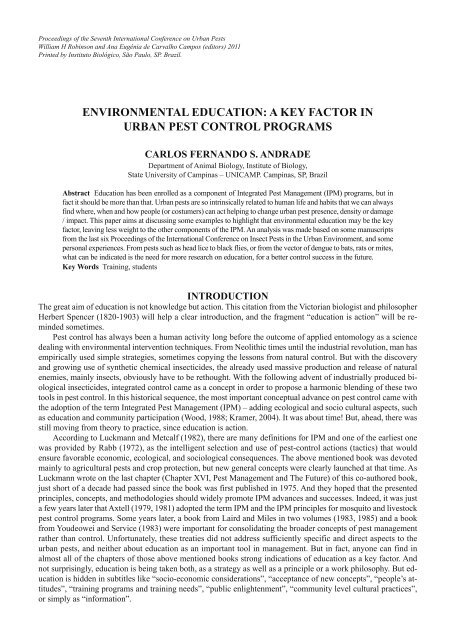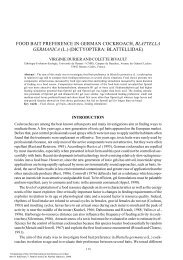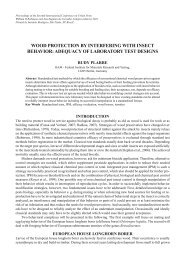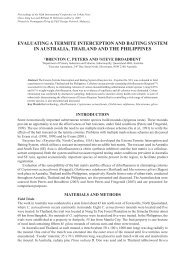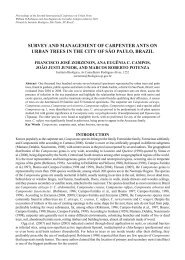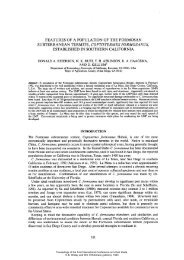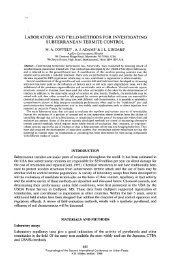Full paper - International Conference on Urban Pests
Full paper - International Conference on Urban Pests
Full paper - International Conference on Urban Pests
You also want an ePaper? Increase the reach of your titles
YUMPU automatically turns print PDFs into web optimized ePapers that Google loves.
Proceedings of the Seventh <str<strong>on</strong>g>Internati<strong>on</strong>al</str<strong>on</strong>g> <str<strong>on</strong>g>C<strong>on</strong>ference</str<strong>on</strong>g> <strong>on</strong> <strong>Urban</strong> <strong>Pests</strong><br />
William H Robins<strong>on</strong> and Ana Eugênia de Carvalho Campos (editors) 2011<br />
Printed by Instituto Biológico, São Paulo, SP. Brazil.<br />
ENVIRONMENTAL EDUCATION: A KEY FACTOR IN<br />
URBAN PEST CONTROL PROGRAMS<br />
CARLOS FERNANDO S. ANDRADE<br />
Department of Animal Biology, Institute of Biology,<br />
State University of Campinas – UNICAMP. Campinas, SP, Brazil<br />
Abstract Educati<strong>on</strong> has been enrolled as a comp<strong>on</strong>ent of Integrated Pest Management (IPM) programs, but in<br />
fact it should be more than that. <strong>Urban</strong> pests are so intrinsically related to human life and habits that we can always<br />
find where, when and how people (or costumers) can act helping to change urban pest presence, density or damage<br />
/ impact. This <str<strong>on</strong>g>paper</str<strong>on</strong>g> aims at discussing some examples to highlight that envir<strong>on</strong>mental educati<strong>on</strong> may be the key<br />
factor, leaving less weight to the other comp<strong>on</strong>ents of the IPM. An analysis was made based <strong>on</strong> some manuscripts<br />
from the last six Proceedings of the <str<strong>on</strong>g>Internati<strong>on</strong>al</str<strong>on</strong>g> <str<strong>on</strong>g>C<strong>on</strong>ference</str<strong>on</strong>g> <strong>on</strong> Insect <strong>Pests</strong> in the <strong>Urban</strong> Envir<strong>on</strong>ment, and some<br />
pers<strong>on</strong>al experiences. From pests such as head lice to black flies, or from the vector of dengue to bats, rats or mites,<br />
what can be indicated is the need for more research <strong>on</strong> educati<strong>on</strong>, for a better c<strong>on</strong>trol success in the future.<br />
Key Words Training, students<br />
INTRODUCTION<br />
The great aim of educati<strong>on</strong> is not knowledge but acti<strong>on</strong>. This citati<strong>on</strong> from the Victorian biologist and philosopher<br />
Herbert Spencer (1820-1903) will help a clear introducti<strong>on</strong>, and the fragment “educati<strong>on</strong> is acti<strong>on</strong>” will be reminded<br />
sometimes.<br />
Pest c<strong>on</strong>trol has always been a human activity l<strong>on</strong>g before the outcome of applied entomology as a science<br />
dealing with envir<strong>on</strong>mental interventi<strong>on</strong> techniques. From Neolithic times until the industrial revoluti<strong>on</strong>, man has<br />
empirically used simple strategies, sometimes copying the less<strong>on</strong>s from natural c<strong>on</strong>trol. But with the discovery<br />
and growing use of synthetic chemical insecticides, the already used massive producti<strong>on</strong> and release of natural<br />
enemies, mainly insects, obviously have to be rethought. With the following advent of industrially produced biological<br />
insecticides, integrated c<strong>on</strong>trol came as a c<strong>on</strong>cept in order to propose a harm<strong>on</strong>ic blending of these two<br />
tools in pest c<strong>on</strong>trol. In this historical sequence, the most important c<strong>on</strong>ceptual advance <strong>on</strong> pest c<strong>on</strong>trol came with<br />
the adopti<strong>on</strong> of the term Integrated Pest Management (IPM) – adding ecological and socio cultural aspects, such<br />
as educati<strong>on</strong> and community participati<strong>on</strong> (Wood, 1988; Kramer, 2004). It was about time! But, ahead, there was<br />
still moving from theory to practice, since educati<strong>on</strong> is acti<strong>on</strong>.<br />
According to Luckmann and Metcalf (1982), there are many definiti<strong>on</strong>s for IPM and <strong>on</strong>e of the earliest <strong>on</strong>e<br />
was provided by Rabb (1972), as the intelligent selecti<strong>on</strong> and use of pest-c<strong>on</strong>trol acti<strong>on</strong>s (tactics) that would<br />
ensure favorable ec<strong>on</strong>omic, ecological, and sociological c<strong>on</strong>sequences. The above menti<strong>on</strong>ed book was devoted<br />
mainly to agricultural pests and crop protecti<strong>on</strong>, but new general c<strong>on</strong>cepts were clearly launched at that time. As<br />
Luckmann wrote <strong>on</strong> the last chapter (Chapter XVI, Pest Management and The Future) of this co-authored book,<br />
just short of a decade had passed since the book was first published in 1975. And they hoped that the presented<br />
principles, c<strong>on</strong>cepts, and methodologies should widely promote IPM advances and successes. Indeed, it was just<br />
a few years later that Axtell (1979, 1981) adopted the term IPM and the IPM principles for mosquito and livestock<br />
pest c<strong>on</strong>trol programs. Some years later, a book from Laird and Miles in two volumes (1983, 1985) and a book<br />
from Youdeowei and Service (1983) were important for c<strong>on</strong>solidating the broader c<strong>on</strong>cepts of pest management<br />
rather than c<strong>on</strong>trol. Unfortunately, these treaties did not address sufficiently specific and direct aspects to the<br />
urban pests, and neither about educati<strong>on</strong> as an important tool in management. But in fact, any<strong>on</strong>e can find in<br />
almost all of the chapters of those above menti<strong>on</strong>ed books str<strong>on</strong>g indicati<strong>on</strong>s of educati<strong>on</strong> as a key factor. And<br />
not surprisingly, educati<strong>on</strong> is being taken both, as a strategy as well as a principle or a work philosophy. But educati<strong>on</strong><br />
is hidden in subtitles like “socio-ec<strong>on</strong>omic c<strong>on</strong>siderati<strong>on</strong>s”, “acceptance of new c<strong>on</strong>cepts”, “people’s attitudes”,<br />
“training programs and training needs”, “public enlightenment”, “community level cultural practices”,<br />
or simply as “informati<strong>on</strong>”.
344 Carlos Fernando S. Andrade<br />
My professi<strong>on</strong>al experience as scientist and professor of biology at Unicamp led me during the last 25 years<br />
to teach Biological C<strong>on</strong>trol, Pest Management and Envir<strong>on</strong>mental Educati<strong>on</strong>. My master’s degree in Ecology was<br />
about the integrated c<strong>on</strong>trol and the use of nuclear polyhedrosis virus against the cott<strong>on</strong> American Leaf Worm Alabama<br />
argillacea (in 1981). Our researches at that time were based <strong>on</strong> ecology of natural enemies, chemical and<br />
biological insecticides, insect growth regulators, pherom<strong>on</strong>es and traps, m<strong>on</strong>itoring systems and so <strong>on</strong>. However,<br />
no educati<strong>on</strong> such as strategy or philosophy was included at that time. But educati<strong>on</strong> became crucial in 1983,<br />
when, with a good help from the media, together with some colleagues from the University of Campinas, we<br />
could elucidate, c<strong>on</strong>vince and mobilize farmers, community leaders and politicians. The final act was some lawsuits<br />
against the Ministry of Agriculture to prevent the insane aerial applicati<strong>on</strong>s of toxic insecticides in order to<br />
eradicate (sic) the cott<strong>on</strong> boll weevil, detected in our country that year. Such a history is promised to be written<br />
by the colleague M.E.M. Habib, my mentor at that time, as so<strong>on</strong> as he retires in a near future.<br />
The present <str<strong>on</strong>g>paper</str<strong>on</strong>g> aims at discussing the future. And also to discuss educati<strong>on</strong> as a key factor, meaning also<br />
a philosophy and the axis for most urban pest management programs, in order to promote acti<strong>on</strong>s. Some c<strong>on</strong>siderati<strong>on</strong>s<br />
<strong>on</strong> the involvement of educati<strong>on</strong> in c<strong>on</strong>trol attempts in the past will help to address the subject as well as<br />
some pers<strong>on</strong>al experiences of mine.<br />
MATERIALS AND METHODS<br />
Far from trying to do a meta-analysis, just a simple search was d<strong>on</strong>e <strong>on</strong> the <str<strong>on</strong>g>Internati<strong>on</strong>al</str<strong>on</strong>g> <str<strong>on</strong>g>C<strong>on</strong>ference</str<strong>on</strong>g> <strong>on</strong> <strong>Urban</strong><br />
<strong>Pests</strong> (ICUP) web site archives for a discussi<strong>on</strong>. The search at the site can be d<strong>on</strong>e by categories, and allows<br />
access both to the “Abstracts” or the “<str<strong>on</strong>g>Full</str<strong>on</strong>g> Paper” presented or to the “Poster Abstracts”. Initially a search for the<br />
term educati<strong>on</strong> was d<strong>on</strong>e, c<strong>on</strong>sidering the category “Abstracts”. Then another search was carried out for the same<br />
term for all categories (titles, authors, key words, and abstracts). The full references are not provided here <strong>on</strong>ce<br />
the texts can be easily accessed <strong>on</strong> the ICUP web site (http://www.icup.org.uk/icupsearch.asp). To address my<br />
percepti<strong>on</strong> that educati<strong>on</strong>, in fact, could and should be more c<strong>on</strong>sidered and enrolled <strong>on</strong> IPM practices, a study<br />
<strong>on</strong> the text of some full <str<strong>on</strong>g>paper</str<strong>on</strong>g>s not found by the search engine will help the discussi<strong>on</strong>.<br />
RESULTS AND DISCUSSION<br />
Using the search engine <strong>on</strong> the IUCP website for the Proceedings of the 1 st and the 2 nd <str<strong>on</strong>g>Internati<strong>on</strong>al</str<strong>on</strong>g> <str<strong>on</strong>g>C<strong>on</strong>ference</str<strong>on</strong>g><br />
<strong>on</strong> Insect Pest in the <strong>Urban</strong> Envir<strong>on</strong>ment, we can find str<strong>on</strong>g indicati<strong>on</strong>s that educati<strong>on</strong> could and should be more<br />
and better c<strong>on</strong>sidered. For the two c<strong>on</strong>ferences, <strong>on</strong>ly <strong>on</strong>e full <str<strong>on</strong>g>paper</str<strong>on</strong>g> was found for the term of search “educati<strong>on</strong>”<br />
as key word. If the same term of search is used for all categories, two full <str<strong>on</strong>g>paper</str<strong>on</strong>g>s and <strong>on</strong>e poster presentati<strong>on</strong> can<br />
be found. The <str<strong>on</strong>g>paper</str<strong>on</strong>g> found with “educati<strong>on</strong>” comm<strong>on</strong> for both the searches was presented in the <str<strong>on</strong>g>C<strong>on</strong>ference</str<strong>on</strong>g> at<br />
Cambridge, 1993, by Alan C. York (Title: “An Educati<strong>on</strong>al Assist to <strong>Urban</strong> Pest Management”). The other two<br />
were, respectively, <strong>on</strong> tutorials for training program for pest c<strong>on</strong>trol operators (PCO) or interested individuals<br />
(presented by Fasulo and Koehler, at Edinburgh, 1996) and <strong>on</strong> health educati<strong>on</strong> aspects for cockroach c<strong>on</strong>trol, by<br />
Christine Brown (at Cambridge, 1993). The educative approach of the three presentati<strong>on</strong>s is obvious and I would<br />
like to c<strong>on</strong>gratulate and to transcribe some phrases by the Purdue University professor Alan York <strong>on</strong> his introducti<strong>on</strong>,<br />
i.e., “I’ve c<strong>on</strong>cluded from my 25 years of research, extensi<strong>on</strong>, and teaching activities that a different approach<br />
must be made in dealing with those <strong>on</strong>e wishes would implement pest management. … (IPM) is a philosophy<br />
and not a technology. It is acceptance of a belief, a set of principles, a set of guidelines by means of which <strong>on</strong>e<br />
then implement certain technological applicati<strong>on</strong>s” and “…we must implement new educati<strong>on</strong>al approaches if<br />
IPM is to be adopted significantly in the urban and rural communities. C<strong>on</strong>sumer attitudes must be changed”.<br />
Professor York clearly indicated a need for researches and educati<strong>on</strong> as acti<strong>on</strong>.<br />
By reading some manuscripts presented in both the first and the sec<strong>on</strong>d ICUP that were not found in the above<br />
search, we can find clear menti<strong>on</strong>s <strong>on</strong> aspects of educati<strong>on</strong>. Such finds may indicate that educati<strong>on</strong> really matters,<br />
but unfortunately it has been poorly or miss c<strong>on</strong>sidered, and even transversally and badly approached.<br />
Sbragia (from the company DowElanco) presented the article “Current Issues in <strong>Urban</strong> Entomology: Resistance,<br />
Legislati<strong>on</strong>, and Public Percepti<strong>on</strong>s” (ICUP at Cambridge, 1993) and it was literally pointed that “…as an<br />
industry, (we) need to do a lot of things better – specifically: 1- Focus <strong>on</strong> the needs of the costumer. …Believe<br />
me; giving them what they want will be far easier than changing their opini<strong>on</strong>”. In fact, it may be easier to follow<br />
Sbragia advice. But if educati<strong>on</strong> is to be the axis, an industry (and by extensi<strong>on</strong> the PCOs) should investigate and<br />
deal with the costumer opini<strong>on</strong>s and c<strong>on</strong>sumer sentiments, which are based <strong>on</strong> their knowledge and understanding<br />
of the problem. The slogan “what you want is what you get” may not be always good, safe, envir<strong>on</strong>mentally acceptable<br />
or even efficient when we are managing urban pests, even if sometimes possible or affordable.
Envir<strong>on</strong>mental Educati<strong>on</strong>: A Key Factor in <strong>Urban</strong> Pest C<strong>on</strong>trol Programs 345<br />
A good example for this subject may be, I think, some programs <strong>on</strong> the nuisance black fly (Simuliidae) populati<strong>on</strong><br />
c<strong>on</strong>trol. From the southeastern coastal areas of Brazil to Argentina, Simulium pertinax used to be the worst<br />
biting fly and nuisance pest, imposing some health problems to humans and ec<strong>on</strong>omic loss to tourism and family<br />
agriculture. Highly temephos resistant populati<strong>on</strong>s and the high cost bacterial products based <strong>on</strong> Bacillus<br />
thuringiensis israelensis importati<strong>on</strong> from USA made most programs very difficult and critical in the 1980s (Andrade,<br />
1987; Andrade and Castello Branco, 1990). For some years we have investigated in the municipality of Ilhabela<br />
(State of São Paulo, Brazil) how many bites people could tolerate a day – as an approach to the IPM<br />
c<strong>on</strong>cept of Ec<strong>on</strong>omic Injury Threshold and Ec<strong>on</strong>omic Injury Level (also known as Aesthetic Injury Level (AIL)<br />
- The level of pest abundance above which aesthetic or sociological c<strong>on</strong>siderati<strong>on</strong>s suggest c<strong>on</strong>trol measures<br />
should be taken against the pest (See http://www.blackwellpublishing.com/Towns). In short, we had some obvious<br />
results. Low-income and poorly educated resident people said they could tolerate as much as they were being bitten,<br />
but they wish less bites. Regular tourists for the summer seas<strong>on</strong>, occasi<strong>on</strong>al visitors and high-income residents<br />
said they couldn’t tolerate it anymore, and they wished zero bites. And, not amazingly, after some explanati<strong>on</strong>s<br />
about blackfly biology, the shortage of available techniques and products, and how difficult for a state c<strong>on</strong>trol<br />
program deal with larviciding treatments for each 15 days, all the year l<strong>on</strong>g, applied to almost all the streams near<br />
the urban areas (actually, a lot of streams), some change was found in the opini<strong>on</strong>s. The people from the first<br />
group changed their view indicating they wish now less bites and the people for the sec<strong>on</strong>d group changed for<br />
anything other than zero bites. So, educati<strong>on</strong> can at least quantitatively change the client’s wishes.<br />
Another example shows that the impossible may be possible occasi<strong>on</strong>ally. Many years ago a PCO company<br />
owner c<strong>on</strong>fidentially told me during a meeting in Posadas, Argentina, that the president of the republic that time,<br />
Carlos Menen, eventually used to enjoy two days in a beautiful ranch <strong>on</strong> the edge of the La Plata River. The owner<br />
of the ranch, his client, obviously demanded zero bites of black flies during those days. The soluti<strong>on</strong>, for two days<br />
<strong>on</strong>ly, was a huge spray bath of piretroids <strong>on</strong> the ranch’s buildings and facilities.<br />
Searching through the hard copy of the Proceedings of the 1st and the 2nd <str<strong>on</strong>g>Internati<strong>on</strong>al</str<strong>on</strong>g> <str<strong>on</strong>g>C<strong>on</strong>ference</str<strong>on</strong>g> <strong>on</strong> Insect<br />
Pest in the <strong>Urban</strong> Envir<strong>on</strong>ment (Wildey and Robins<strong>on</strong>, 1993; Wildey, 1996) it can be found educati<strong>on</strong> (or lack of<br />
educati<strong>on</strong> instead) involved in many manuscripts, but not menti<strong>on</strong>ed or literally c<strong>on</strong>sidered as important to be<br />
treated. C.F. Curtis (Manuscript title: “Alternatives to C<strong>on</strong>venti<strong>on</strong>al Insecticides for <strong>Urban</strong> Vector and Pest C<strong>on</strong>trol”,<br />
ICUP at Cambridge, 1993) regret that “residual house spraying is an unpopular method with residents of<br />
houses with painted walls, or who have believed lurid accounts in the media of the supposed dangers of insecticides,<br />
or who are dissatisfied with the inability of house spraying to deal with nuisance Culex mosquitoes”. And,<br />
some lines bellow this citati<strong>on</strong>, Curtis menti<strong>on</strong>s that in Cuba the eliminati<strong>on</strong> of Aedes aegypti breeding sites in<br />
the houses is effective because is rigorously applied. He doesn’t comment, but we know that educati<strong>on</strong> is a key<br />
factor in Cuba, both as a philosophy and as well as acti<strong>on</strong>.<br />
J.H. Hainze, from the company S.C. Johns<strong>on</strong> & S<strong>on</strong>, Inc., presented his manuscript which title deeply promised<br />
to c<strong>on</strong>sider “educati<strong>on</strong>” as important, i.e., “C<strong>on</strong>sumer Based Strategies for Household Insect C<strong>on</strong>trol” (ICUP<br />
at Cambridge, 1993). He used more than 7,000 words and made no citati<strong>on</strong> of the words “educati<strong>on</strong>” or “instructi<strong>on</strong>”<br />
or even “informati<strong>on</strong>”. Am<strong>on</strong>g six points that help clarify the basis for the insect c<strong>on</strong>trol strategies employed,<br />
he pointed out that: “1. Relative to other insect c<strong>on</strong>trol activities, the end user is an amateur, with little knowledge<br />
of the insect or the c<strong>on</strong>trol device/chemical” and “3. Since the user has little understanding of the product, there<br />
is c<strong>on</strong>siderable potential for misuse or misapplicati<strong>on</strong>. Therefore, the product must be somewhat “foolproof” in<br />
its formulati<strong>on</strong> and design to ensure that the c<strong>on</strong>sumer will obtain a satisfactory result”. In theory, the companies<br />
do not even need a brain if they have totally foolproof products. But since a company aims at a “somewhat foolproof”<br />
product, why not apply IPM principles, working to change the menti<strong>on</strong>ed “little understanding of the insect<br />
or the c<strong>on</strong>trol device/chemical” to a better degree of understanding?<br />
Head lice IPM may essentially be based <strong>on</strong> educati<strong>on</strong>. Not just as a key factor, but more, as the main factor, or<br />
even as the <strong>on</strong>ly factor. By means of educati<strong>on</strong> (as acti<strong>on</strong>), parents should be able to carry out regular surveillance<br />
and an efficient head lice c<strong>on</strong>trol <strong>on</strong> their children. Parents can do the same about the friends and relatives that live<br />
and play with their children, and can help educating other parents to do the same. Although focusing mainly <strong>on</strong> products,<br />
the manuscript from Richard C. Russell (“Requirements and Problems for C<strong>on</strong>trol of Some Arthropods <strong>Pests</strong><br />
of Medical Importance in <strong>Urban</strong> Australia”, ICUP at Cambridge, 1993) pointed out some critical issues for this questi<strong>on</strong>.<br />
Russell menti<strong>on</strong>ed that “More community educati<strong>on</strong> is an imperative, and should be directed towards a better<br />
understanding am<strong>on</strong>gst parents that head lice are a community problem, that there is no stigma associated with infestati<strong>on</strong>,<br />
and that children and c<strong>on</strong>tacts within and outside of the family of the pers<strong>on</strong> with an infestati<strong>on</strong> must be<br />
treated effectively in order to c<strong>on</strong>trol the problem within the community”. We have to completely agree.
346 Carlos Fernando S. Andrade<br />
More than ten years ago, sp<strong>on</strong>sored by the company Johns<strong>on</strong> & Johns<strong>on</strong>, my research group started searching<br />
for good botanical pediculicide formulae. We were c<strong>on</strong>tacted that time by a pers<strong>on</strong> that for many years produced,<br />
sold or gave hundreds of liters of his pediculicide shampoo. It was a botanical formula and a familiar secret,<br />
passed from his grandmother and allegedly very efficient. He sent us a sample and instructi<strong>on</strong>s. We carried out a<br />
double blind assay in parallel with a comm<strong>on</strong> Johns<strong>on</strong> & Johns<strong>on</strong> shampoo. The treatments for this bioassay were<br />
carried out, exposing groups of 30 adults plus 10 nymphs of head lice to the shampoo for <strong>on</strong>e minute, gently rubbing<br />
to make foam. The insects were then maintained <strong>on</strong> the shampoo foam for <strong>on</strong>e hour, according to the instructi<strong>on</strong>s,<br />
and after this period, they were washed, rinsed and allowed to blood feed. The mean mortality was<br />
recorded at the end of the treatment and for <strong>on</strong>e, five, nine, 16 and 24 hours after treatment. No expressive mean<br />
mortality could be noted for both the shampoos and reached 22.5% for the botanical formula and 13.5% for the<br />
n<strong>on</strong> pediculicide shampoo (unpublished data). Even so, we can attest that the botanical formula should be actually<br />
very good, c<strong>on</strong>sidering what that pers<strong>on</strong> said additi<strong>on</strong>ally. He explained that he used to insist with his costumers<br />
to repeat the treatment every day, for <strong>on</strong>e week, proceeding carefully a combing with the nit comb while the hairs<br />
were still wet. Here we find educati<strong>on</strong> in acti<strong>on</strong>, instead of chemical c<strong>on</strong>trol. Our group followed searching for<br />
new shampoo and loti<strong>on</strong> formulae, but we create also in 2002 an Internet domain (headlice.org.br , in Portuguese)<br />
mainly devoted to educati<strong>on</strong> and the use of suffocati<strong>on</strong> and regular nit combing as the main strategy for head lice<br />
c<strong>on</strong>trol ( see http://www.piolho.org.br/).<br />
Another example can be found <strong>on</strong> the manuscript “Preventi<strong>on</strong> and Exterminati<strong>on</strong> Strategies for House<br />
Dust Mites and their Allergens in Home Textiles”, presented by Johanna Van Br<strong>on</strong>swijk (ICUP at Cambridge,<br />
1993). The abstract starts with “Preventing and exterminating clinically relevant c<strong>on</strong>centrati<strong>on</strong>s of house dust<br />
mite allergen in the urban envir<strong>on</strong>ment is <strong>on</strong>e of the more interesting challenges for architects and building engineers,<br />
pest c<strong>on</strong>trol c<strong>on</strong>tractors, cleaning services, and sanitary biologists, as well as patients and physicians”.<br />
Reading the manuscript and the c<strong>on</strong>cerns addressed, it is very easy to rewrite this starting point by adding “envir<strong>on</strong>mental<br />
educators” am<strong>on</strong>g the professi<strong>on</strong>als enrolled as challenged. Indeed, we can hope that the menti<strong>on</strong>ed<br />
“sanitary biologists” could play a part in the educati<strong>on</strong> needed in order to manage home envir<strong>on</strong>ment, to help<br />
lower mite infestati<strong>on</strong>s. But the author does not indicate this role of sanitary biologists as his proposal.<br />
Cockroach c<strong>on</strong>trol permits good examples where educati<strong>on</strong> was miss-c<strong>on</strong>sidered and can be discussed. The<br />
manuscript “Cockroach C<strong>on</strong>trol in the Netherlands” (by J. T. De J<strong>on</strong>ge, ICUP at Cambridge, 1993) and specifically<br />
the final lines of its abstract are obviously enough to indicate this, i.e., “There are some indicati<strong>on</strong>s that resistance<br />
against insecticides is becoming important. However at the moment in most cases cockroach c<strong>on</strong>trol can be carried<br />
out successfully, especially when there has been great care taken in c<strong>on</strong>vincing the occupants or organizati<strong>on</strong>s<br />
c<strong>on</strong>cerned that their co- operati<strong>on</strong> is essential”. In the discussi<strong>on</strong>, we can also find phrases such as “Only when<br />
the co-operati<strong>on</strong> of the inhabitants was poor there were problems with the results of the acti<strong>on</strong>” and “The most<br />
important reas<strong>on</strong> however why populati<strong>on</strong>s of the German cockroach are not completely destroyed is the fact that<br />
in a substantial part of the cases co-operati<strong>on</strong> of the inhabitants of houses is refused”. It seems clear that the point<br />
here is unc<strong>on</strong>vinced occupants and poor or refused co-operati<strong>on</strong>. And it seems also clear so, that despite the indicati<strong>on</strong>s<br />
that resistance of the German cockroach was becoming important, the most important actually was how<br />
to educate in order to get the acti<strong>on</strong> of co-operati<strong>on</strong>.<br />
Also, from the manuscript “Computer Aided Decisi<strong>on</strong> Support System for American Cockroach Management<br />
in the <strong>Urban</strong> Envir<strong>on</strong>ment” by N<strong>on</strong>ggang Bao and Robins<strong>on</strong> (ICUP at Cambridge, 1993) we can highlight the<br />
role that an envir<strong>on</strong>mental educator may play. The authors pointed out in the introducti<strong>on</strong> that “An urban IPM<br />
program must c<strong>on</strong>sider more directly the sociological and psychological needs of the target audience, rather than<br />
ec<strong>on</strong>omic measurements that are standardized in agricultural IPM programs. The aesthetic injury level (AIL) c<strong>on</strong>cept<br />
was proposed to resp<strong>on</strong>d to these needs…”. And, appropriately, they presented a program for a decisi<strong>on</strong> aid<br />
system that involves clients’ (Individual or Collective) attitudes. The example supplied by Bao and Robins<strong>on</strong><br />
refers to a hypothetical American cockroach infestati<strong>on</strong> in a large apartment complex, and they explain “Determinati<strong>on</strong><br />
of the aesthetic injury level in MACDAS was achieved by asking the user to input the relevant attitudes<br />
of the target audience towards an American cockroach infestati<strong>on</strong> and c<strong>on</strong>trol. Specifically, a group of residents<br />
were surveyed by the decisi<strong>on</strong> maker, the property manager, or pest c<strong>on</strong>trol specialist”. My questi<strong>on</strong> is that this<br />
final step could better be “Specifically, most (or almost all) of the residents were surveyed…” c<strong>on</strong>sidering that<br />
cockroach in any apartment complex is a collective problem. The AIL therefore, may be fixed by everybody, or<br />
a huge majority of the residents.<br />
Recently, I had a good example for the difference we can find am<strong>on</strong>g the enrollment of a group of residents<br />
versus almost all residents, when dealing with a collective urban pest. My wife and I, together, carried out a simple
Envir<strong>on</strong>mental Educati<strong>on</strong>: A Key Factor in <strong>Urban</strong> Pest C<strong>on</strong>trol Programs 347<br />
educati<strong>on</strong>al approach am<strong>on</strong>g seven neighbors living in a small rural community in order to c<strong>on</strong>vince them to<br />
repair the covers of the septic tanks in their houses, thereby inducing other neighbors to do the same, to help eliminate<br />
the source of the nuisance mosquito Culex quinquefasciatus infestati<strong>on</strong> in the neighborhood (Andrade and<br />
Nascimento, 2010). We expected (not too much, really in fact) that the high lowering of nocturnal biting attacks<br />
from the mosquitoes that we experienced for the following weeks <strong>on</strong> that place should be enough to spread this<br />
acti<strong>on</strong> for the rest of the community, but it did not. Six m<strong>on</strong>ths after, a student attending to my summer course of<br />
Envir<strong>on</strong>mental Educati<strong>on</strong> carried out the same project and showed us how to succeed. During <strong>on</strong>e week he visited<br />
all the 100 properties (dwellings, local shops and other buildings such as churches and the school) at the same<br />
community. He also teaches aspects of the bio-ecology of the house mosquito to about 60 children from first to<br />
fifth grade at the <strong>on</strong>ly local school. As a result, 10 of the owners took immediate corrective acti<strong>on</strong>s, capping sighs<br />
and sealing cracks in the covers of the septic tanks. Other acti<strong>on</strong>s were taken for 18 owners in the following days,<br />
resulting in 28 successfully directed interventi<strong>on</strong>s in the community (Johansen, 2011). No matches can be<br />
found for the search term “educati<strong>on</strong>” <strong>on</strong> the proceedings of ICUP at Edinburgh, 1996, for the categories Key<br />
Words or Titles. Two presentati<strong>on</strong>s therefore are related to Culex surveillance and c<strong>on</strong>trol in urban areas and<br />
permit following a discussi<strong>on</strong> <strong>on</strong> this annoying and vector mosquito. The manuscript “Physical and Chemical<br />
Properties of Different Types of Mosquito Aquatic Breeding Places in Kuwait State” by A.M. Salit and co-authors<br />
and the poster abstract “An IPM Programme Against Culex (Culex) pipiens L.,1758 in Valencia Regi<strong>on</strong> (Spain)”<br />
by E. Corella and co-authors. In Spain, various c<strong>on</strong>trol measures were carried out from 1986 to 1995. The authors<br />
reported an IPM program directed against immature stages in more than 325 foci detected in the city of Valencia,<br />
listing sanitati<strong>on</strong> and the use of chemical and biological insecticides, as well as the use of two cyprinod<strong>on</strong>tidae<br />
fishes (Valencia hispanica and Aphanius iberus). In Kuwait, the team of researchers found Culex pipiens in almost<br />
all ten types of breeding places, i.e., animal watering basins, seepage of water from agriculture and animal enclosures<br />
c<strong>on</strong>diti<strong>on</strong>ing, swamps and sewerage water with Gulf water, manure fermentati<strong>on</strong> basins, water irrigati<strong>on</strong><br />
channels, storm drains, sewerage manholes, inspecti<strong>on</strong> chambers, artificial lakes with stagnant water and fountains.<br />
In both situati<strong>on</strong>s, Spain and Kuwait, educati<strong>on</strong> or community participati<strong>on</strong> is not enrolled as strategy, but may<br />
play a role. Since most of breeding places for Culex pipiens complex is manmade, we can find all around the<br />
world many good examples of people attitudes helping official c<strong>on</strong>trol programs, and it must be stimulated.<br />
From 3rd ICUP at Prague, Czech Republic, 1999 to the last <strong>on</strong>e in Budapest, Hungary, 2008 we can identify<br />
and summarize two posters and <strong>on</strong>e full <str<strong>on</strong>g>paper</str<strong>on</strong>g> in 1999, <strong>on</strong>e poster in 2002, four posters in 2005 and two posters<br />
and three full <str<strong>on</strong>g>paper</str<strong>on</strong>g>s in 2008 <strong>on</strong> the ICUP web site search engine, using the term educati<strong>on</strong> used for all categories<br />
of search.<br />
In 1999, M. Waldvogel and co-authors, published that the ultimate goal of their study was to deliver an educati<strong>on</strong><br />
program to producti<strong>on</strong> managers to allow them to c<strong>on</strong>tinue an effective site-based pest management strategy<br />
of cockroaches in c<strong>on</strong>fined swine producti<strong>on</strong> at North Carolina. Dr. Bulent Alten and S. S. Caglar presented integrated<br />
c<strong>on</strong>trol strategies against mosquitoes, house fly and sand flies for the Belek Tourism Center, an area<br />
which is surrounded by Mediterranean and called the Turkish Riviera. Accordingly, they outlined educati<strong>on</strong> studies<br />
as the first step and then, in sec<strong>on</strong>d place, what they called Integrated C<strong>on</strong>trol Studies comprising A. Infrastructure<br />
studies and physical arrangements; B. Bio-ecological studies; C. Chemical c<strong>on</strong>trol studies and D. Biological c<strong>on</strong>trol<br />
studies. Also in 1999, Dr. N. Hill, from the Disease C<strong>on</strong>trol and Vector Biology Unit, L<strong>on</strong>d<strong>on</strong> School of Hygiene<br />
and Tropical Medicine, presented the poster “Why are we failing to c<strong>on</strong>trol Head Lice with insecticides”<br />
enrolling educati<strong>on</strong> as a fundamental tool.<br />
The <strong>on</strong>ly poster abstract <strong>on</strong> ICUP 2002 (at Charlest<strong>on</strong>, USA) menti<strong>on</strong>ing educati<strong>on</strong> was from B.M. Kard and<br />
co-authors. They inform that the need to progressively improve structural and urban pest-management training<br />
for state regulatory officials, pest-management professi<strong>on</strong>als, and extensi<strong>on</strong> educators has led to the development<br />
and implementati<strong>on</strong> of a limited number of university-based training schools in the United States. Then, they presented<br />
the goal of an Educati<strong>on</strong> Facility for Structural and <strong>Urban</strong> Pest C<strong>on</strong>trol at Oklahoma State University. The<br />
objective: “to provide this training relative to subterranean termite management under a variety of standard and<br />
unique building materials applicati<strong>on</strong>s and c<strong>on</strong>structi<strong>on</strong> practices found in Oklahoma and c<strong>on</strong>tiguous states”, i.e.,<br />
educati<strong>on</strong> for PCOs and technicians and no references to costumers. But in the 2005 ICUP (at Singapore), the<br />
poster abstract from A. Morgan seems to have better addressed the role of educati<strong>on</strong> for termite c<strong>on</strong>trol. It was<br />
informed that an initiative known as “Operati<strong>on</strong> <str<strong>on</strong>g>Full</str<strong>on</strong>g>stop” (from the Louisiana State University Agricultural<br />
Center, in cooperati<strong>on</strong> with USDA) began in 1998 and was carried out through a 15-block area in the New Orleans<br />
French Quarter. He wrote that the goal of the program, i.e., to reduce densities of the Formosan termite and validate<br />
the effectiveness of area-wide management, was achieved, but it became evident, however, that the program
348 Carlos Fernando S. Andrade<br />
needed to be evaluated from the viewpoint of the participants. He reports then a survey for all the 225 property<br />
owners and managers of the original 15-block and c<strong>on</strong>cluded that they were knowledgeable about termite biology,<br />
identificati<strong>on</strong>, preventi<strong>on</strong>, c<strong>on</strong>trol, and management. Also, the majority of the participants indicated that the program<br />
was important, effective, and should be c<strong>on</strong>tinued and expanded to other areas. For the final lines of his abstract,<br />
A. Morgan wrote “Therefore, based <strong>on</strong> the results of the study, c<strong>on</strong>tinued research and educati<strong>on</strong>al efforts<br />
directed towards managing the Formosan subterranean termite would be justified”, and we must c<strong>on</strong>gratulate<br />
with this approach.<br />
The other three poster abstracts from the ICUP 2005 (at Singapore) menti<strong>on</strong>ing educati<strong>on</strong> are from a<br />
team of 16 Iranian researchers. Two abstracts were about bed nets and malaria and/or cutaneous leishmaniasis,<br />
and the third reports prevalence rates of arthropod borne diseases in children of urban areas of Iran, in order to<br />
generate baselines for health educati<strong>on</strong> authorities to design a health educati<strong>on</strong>al program.<br />
The ICUP at Cambridge and the presentati<strong>on</strong>s of those two menti<strong>on</strong>ed (criticized) before researches involving<br />
cockroach c<strong>on</strong>trol, i.e., <strong>on</strong> the program for a decisi<strong>on</strong> aid system involving individual or collective clients’<br />
attitudes and “Cockroach C<strong>on</strong>trol in the Netherlands” were in 1993. Fifteen years later, during the IUCP 2008 (in<br />
Budapest), <strong>on</strong>e full <str<strong>on</strong>g>paper</str<strong>on</strong>g> and <strong>on</strong>e poster presentati<strong>on</strong> were <strong>on</strong> a correlate subject. Respectively, D<strong>on</strong> Rivard from<br />
the Bost<strong>on</strong> University School of Public Health and co-authors presented “Integrated Pest Management Educator<br />
Pilot Project” and C. Wang and G.W. Bennett presented “Integrated Pest Management Strategies to Manage Cockroaches<br />
and Reduce Cockroach Allergen Levels in Multi-Family Housing”. Both researches are c<strong>on</strong>sistently directed<br />
to educati<strong>on</strong> as a philosophy and as a tool. D<strong>on</strong> Rivard team proposed a peer educator model (IPM Educator)<br />
in public housing as a comp<strong>on</strong>ent of IPM. And they report that, before the product treatment, residents received<br />
written notice to prepare their units for the applicati<strong>on</strong>. And before a sec<strong>on</strong>d and a third treatment, an IPM Educator<br />
instructed residents <strong>on</strong> cockroach biology and habits, preparati<strong>on</strong> for treatment, and the role of sanitati<strong>on</strong> in pest<br />
c<strong>on</strong>trol. They c<strong>on</strong>cluded that the “IPM peer educator is a low-cost model of educating and engaging residents of<br />
low- income, multi-family housing. It is also a potential source of professi<strong>on</strong>al training and jobs for public housing<br />
and other low-income housing residents”. C. Wang and G.W. Bennett reports an IPM program for 400 apartments<br />
in Gary, Indiana. The program c<strong>on</strong>sisted of dem<strong>on</strong>strati<strong>on</strong> and educati<strong>on</strong> of residents, chemical c<strong>on</strong>trol, and sticky<br />
traps. They report that the program was highly effective in maintaining cockroach infestati<strong>on</strong>s at very low levels,<br />
reducing cockroach allergens, and reducing insecticide use. It seems now that the comm<strong>on</strong> setbacks and difficulties<br />
related to lack of cooperati<strong>on</strong> from residents have been overcome.<br />
The last report <strong>on</strong> the IUCP 2008 (at Budapest), to be commented <strong>on</strong>, is the full <str<strong>on</strong>g>paper</str<strong>on</strong>g> from Stephen L. Doggett<br />
and Richard C. Russell “The Resurgence of Bed Bugs, Cimex spp. (Hemiptera: Cimicidae) in Australia”. They<br />
are from the Department of Medical Entomology and the University of Sydney. The <str<strong>on</strong>g>paper</str<strong>on</strong>g> inform that Australia<br />
experienced a resurgence of two species of bed bugs resulting in a high ec<strong>on</strong>omic impact, and a official program<br />
was implemented with four points, being the third <strong>on</strong>e the educati<strong>on</strong> of stakeholders affected by bed bugs. The<br />
government produced, as they cited, “numerous <str<strong>on</strong>g>paper</str<strong>on</strong>g>s (17) for various industries journals, including the following<br />
groups; pest managers, hotel/motel management, housekeepers, student accommodati<strong>on</strong> managers, hotel engineers<br />
and envir<strong>on</strong>mental health officers”. As <strong>on</strong>e of their c<strong>on</strong>clusi<strong>on</strong>s, they menti<strong>on</strong>ed that “educati<strong>on</strong> and training of<br />
pest managers, the accommodati<strong>on</strong> industry and other stakeholders in best practice management is essential in<br />
order to ensure proper c<strong>on</strong>trol is undertaken, which in turn should minimize the spread of the insect”.<br />
Finally, and c<strong>on</strong>sidering the title of the present panel of discussi<strong>on</strong> (“The Future of the <strong>Urban</strong> Pest Research”),<br />
I am obliged to propose to the next ICIPUE, the panel titled “Researches <strong>on</strong> Educati<strong>on</strong> in <strong>Urban</strong> Pest Management”.<br />
REFERENCES CITED<br />
Andrade, C.F.S. 1987. Blackly Integrated Pest Management. Proceedings of the 11th Brazilian C<strong>on</strong>gress of Entomology,<br />
Campinas, SP – July 1987. Cargill Foundati<strong>on</strong> ed. 1989. Pp.140-157 (in Portuguese).<br />
Andrade, C.F.A. and Castello Branco Jr. A., 1990. Methods for field detecti<strong>on</strong> of resistance to temephos in<br />
simuliids – Larval esterase level and topical applicati<strong>on</strong> of the insecticide to adults. Mem. Inst. Oswaldo Cruz,<br />
85(3):219-297.<br />
Andrade, C.F.A. and Nascimento, M.C.M. 2010. C<strong>on</strong>trole de Culex quinquefasciatus (Diptera: Culicidae) pela<br />
Eliminação de Criadouros no Bairro da Graúna, Paraty–RJ. Rev. C<strong>on</strong>trole Biológico BE300. 2:33-39. Available<br />
(in Portuguese) at http://www2.ib.unicamp.br/profs/eco_aplicada/revistas/be300_vol2_8.pdf<br />
Axtell, R.C. 1979. Principles of integrated pest management (IPM) in relati<strong>on</strong> to mosquito c<strong>on</strong>trol. Mosquito<br />
News, J. Amer. Mosquito C<strong>on</strong>trol Assoc. 39: 709-718.
Envir<strong>on</strong>mental Educati<strong>on</strong>: A Key Factor in <strong>Urban</strong> Pest C<strong>on</strong>trol Programs 349<br />
Axtell, R.C. 1981. Livestock integrated pest management (IPM): Principles and prospects. pp. 31-40. In: Knapp,<br />
F.W. (ed.), Systems Approach to Animal Health and Producti<strong>on</strong>. Univ. Kentucky, Lexingt<strong>on</strong>, 241 p.<br />
Straus, E.E., and Knight, J. D. 1997. Microbial insecticides: Can farmers be persuaded to use them? In “Microbial<br />
Insecticides: Novelty or Necessity?” (H. F. Evans, chair). Proc. Br. Crop Prot. Council Symp. 68, 141–<br />
150.<br />
Johansen, I.C., 2011. Educação Ambiental e Mobilização Social para o C<strong>on</strong>trole do Mosquito Culex quinquefasciatus<br />
em um Núcleo <strong>Urban</strong>o Isolado em Paraty, RJ. Rev. Educação Ambiental BE597. 4:1-6.<br />
Kramer, R. 2004. Integrated Pest Management. In: Hedges, S.A. and Moreland, D., eds. A. Mallis Handbook or<br />
Pest C<strong>on</strong>trol, Ninth Editi<strong>on</strong>. GIE Media Inc., Cleveland. OH.<br />
Laird, M. and Miles, J.W. 1983. Integrated mosquito c<strong>on</strong>trol methodologies. Volume 1. L<strong>on</strong>d<strong>on</strong>: Academic<br />
Press.<br />
Laird, M. and Miles, J.W. 1985. Integrated mosquito c<strong>on</strong>trol methodologies. Volume 2. Bioc<strong>on</strong>trol and other<br />
innovative comp<strong>on</strong>ents, and future directi<strong>on</strong>s. L<strong>on</strong>d<strong>on</strong>: Academic Press.<br />
Luckmann, W.H. and Metcalf. R.L. 1982. The Pest management C<strong>on</strong>cept. In: Metcalf. R.L. and Luckmann,<br />
W.H. (ed.). Introducti<strong>on</strong> to Insect Pest Management. Sec<strong>on</strong>d Ed. New York: John Wiley & S<strong>on</strong>s.<br />
Youdeowei, A. and Service, M. 1983. Pest and vector management in the tropics: With particular reference to<br />
insects, ticks, mites, and snails. L<strong>on</strong>d<strong>on</strong> and New York: L<strong>on</strong>gman.<br />
Wildey, K.B. and Robins<strong>on</strong>, W.H. (Eds.) 1993. Proc. 1st <str<strong>on</strong>g>Internati<strong>on</strong>al</str<strong>on</strong>g> <str<strong>on</strong>g>C<strong>on</strong>ference</str<strong>on</strong>g> <strong>on</strong> Insect <strong>Pests</strong> in the <strong>Urban</strong><br />
Envir<strong>on</strong>ment, ICIPUE, St. John’s College, Cambridge University, England, 498 pp.<br />
Wildey, K.B. (Ed.) 1996. Proc. 2 nd <str<strong>on</strong>g>Internati<strong>on</strong>al</str<strong>on</strong>g> <str<strong>on</strong>g>C<strong>on</strong>ference</str<strong>on</strong>g> <strong>on</strong> Insect <strong>Pests</strong> in the <strong>Urban</strong> Envir<strong>on</strong>ment, ICIPUE,<br />
Edinburgh, Scotland, 640 pp.<br />
Wood, F.E. 1988. <strong>Urban</strong> Pest Management. Proc. Nati<strong>on</strong>al C<strong>on</strong>f. <strong>Urban</strong> Entomol. 2:5- 13.


